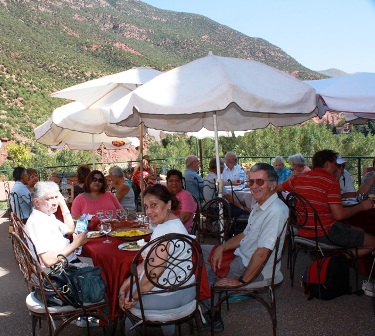
Lunch in the Ourika Valley

Lunch in the Ourika Valley
Read Previous Episode: Marakesh or Next Episode: Essaouira
|
16 October 2009 Morocco – Ourika Valley As much as we prefer to be independent travellers, we occasionally take advantage of a tour. Our day trip to the Ourika Valley, in the High Atlas Mountains about 30 km from Marrakesh, was one such incident. Eleven guests of the Residence Amina set out in a minivan with our guide Aziz. We made several stops along the way. We stopped at a pottery workshop to watch a demonstration of pottery making. We stopped beside a mosque to admire an irrigation canal built just six years ago to bring water to the many gardens and groves of olives and fruits outside the city. More interesting for me was the explanation of numbers painted on the side of the mosque. During election times the 38 recognized political parties post their party’s platforms under designated numbers for all the local residents to read.
Monday is the weekly market day in the village of Tnine. We were there, along with several other tour groups and most of the inhabitants of the area. It was a going concern with meat markets, fruit and vegetable stalls, household goods stalls, barber shops, food booths and whatever else the locals find necessary. Ray and I would have loved to take our time exploring the market but when you are in a group you are hustled along for fear someone would get lost. As it was, a few of our group didn’t heed the warning to ignore the jewelry salesmen. As a result we were shadowed the entire way by men desperately hoping to make just one sale. There were slim pickings with our group and Aziz as our leader.
Our tea was the aperitif for our dinner at a large restaurant at the foot of the Atlas Mountains. We weren’t the only tour group there for lunch but it was very good. We had Moroccan salad, chicken done tajine style, cous cous with vegetables and fruit for desert. As well as the usual bottled water, we shared a bottle of passable Rosé wine, the first alcohol we had drunk in Morocco. Alcohol is available in some better restaurants and bars, but it was either too expensive or not available where we ate. We have become quite used to the teetotaller style, although I am sure that will be forgotten once we return to Paris. Our group passed up the opportunity, for a price, to sit on a camel and have your picture taken at one of a few spots along the mountain road on our way back to the city.
|
Return to Morocco Intro
Return to Travels
Return to Introduction